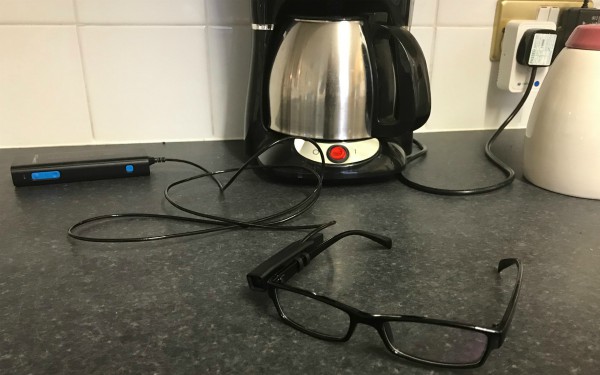
One early-January day, Community Care spent a morning in an untenanted council bungalow in Wigan – on the face of it perhaps an unlikely location to demonstrate how the internet of things is revolutionising assistive technology.
But the local authority has put the small home to use as a showcase for devices it believes can be of use to social workers and health professionals in supporting people to stay living independently. Some are already being used when planning support and reviewing care packages, with more expected to be put into use during 2018.
For more on the project and its implications, read the full story on our trip to Wigan. Here we showcase some of the most interesting pieces of assistive technology on display.
Cameras
Cameras are now being used to promote independent living.
The Orcam MyEye (pictured above) is a different device. Mounting onto the frame of a pair of glasses, it can assist people with visual impairments by reading text, recognising faces and identifying objects. The information is relayed to the wearer via a small earpiece microphone.
The Ring smart video doorbell enables front doors to be answered remotely via friends’ or relatives’ smartphones, which display images of who is standing in the doorway.
Sleeping

The Illumy sleep mask uses pulsing tonal colours to assist with waking and sleeping. Photo: Alex Turner
Several devices in the bungalow are geared around promoting restful sleep which people with learning disabilities, autism, dementia and a range of mental health problems are less likely to experience.
The Illumy sleep mask uses pulsing red-toned light to help wearers become calm and fall asleep and blue tones to assist with waking up. In an adjacent bedroom the Zeeq smart pillow conceals a range of functions including a vibration alarm to encourage movement when snoring is detected, and analysis of sleep quality, which is sent to a smartphone app. Both are likely to be trialled this year.
Eating and drinking

The HAPIfork monitors eating speeds and durations. Photo: Alex Turner
In the kitchen of Wigan council’s bungalow are a number of gadgets to help people maintain eating and drinking habits. The HAPIfork monitors the speed and duration at which meals are eaten, with indicator lights and gentle vibrations alerts if you’re eating too fast.
The Smarter iKettle, meanwhile, is controlled by a smartphone and can have water boiling by the time someone enters their kitchen, meaning people do not have to stand for as long when making a hot drink.

Get an alert on bad eggs with the Quirky-Egg-Minder. Photo: Alex Turner
The Quirky Egg Minder, as its name suggests, keeps tabs on eggs and sends notifications to prevent bad ones being eaten.
“We bought [the latter] as a bit of fun, to show how far tech has gone,” says Stevens, “but actually we’ve had professionals who’ve said ‘I work with someone who cooks and that could be really useful.'”
Sensors

Sensors can now send data to applications and mobile devices. Photo: Alex Turner
Motion detectors have been used for more than a decade so people can keep an unobtrusive eye on elderly relatives. Now, a much more sophisticated array of sensors, which send data to backend applications and communicate with mobile devices, can build detailed pictures of people’s lives to help with care planning.
“We know, if someone has everything in, about temperature, light levels, if they sleep in the living room, when they sit on the sofa, if someone comes to visit them and whether the front door is opened at night,” says Hellen Bowey, chief executive of Alcove, one of the firms whose sensors Wigan uses.
By writing ‘rules’ based on the information the sensors give out, alerts can also be triggered when something goes awry. Bowey cites an example of a woman who fell in her bathroom soon after her carers had left; because sensors recognised that she had entered the room but not left, social care staff were notified within 45 minutes.
Voice-activated assistants
Amazon’s Echo smart speaker, with its digital assistant Alexa, has been being trialled by Wigan council, as well as other authorities such as Hampshire, over the past year. Google’s Home, a competing voice-activated device, was also installed in Wigan’s bungalow when we visited, though Stevens says for the moment its usefulness lags slightly behind.
The digital assistants can help people with reduced mobility or cognitive impairments by enabling voice control of things light lighting, heating and curtains opening or closing, as well as providing reminders, for instance around medication. The Echo, which in its latest ‘Show’ iteration adds a video screen, has also been adapted to facilitate carers checking in and out of people’s homes, and to enable residents to summon help by voice command alone.


 Bournemouth, Christchurch and Poole
Bournemouth, Christchurch and Poole  Hampshire County Council
Hampshire County Council  Lincolnshire County Council
Lincolnshire County Council  Norfolk County Council
Norfolk County Council  Northamptonshire Children’s Trust
Northamptonshire Children’s Trust  South Gloucestershire Council
South Gloucestershire Council  Wiltshire Council
Wiltshire Council  Wokingham Borough Council
Wokingham Borough Council  Children and young people with SEND are ‘valued and prioritised’ in Wiltshire, find inspectors
Children and young people with SEND are ‘valued and prioritised’ in Wiltshire, find inspectors  How specialist refugee teams benefit young people and social workers
How specialist refugee teams benefit young people and social workers  Podcast: returning to social work after becoming a first-time parent
Podcast: returning to social work after becoming a first-time parent  Podcast: would you work for an inadequate-rated service?
Podcast: would you work for an inadequate-rated service?  Family help: one local authority’s experience of the model
Family help: one local authority’s experience of the model  Workforce Insights – showcasing a selection of the sector’s top recruiters
Workforce Insights – showcasing a selection of the sector’s top recruiters 

 Facebook
Facebook X
X LinkedIn
LinkedIn Instagram
Instagram
Comments are closed.